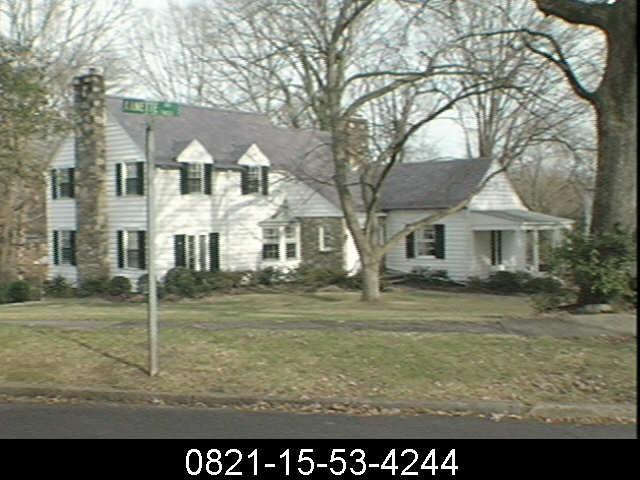1999
William Branson House. Picturesque 2-story Colonial Revival-style house. The main 2-story block has a side-gable slate roof, exterior end stone chimney, and an entrance set in a shed stone bay, with an ornate pilastered surround. In the angle between the façade and entrance shed is a bay window with a concave roof. At left is a French door. The 1 1⁄2- story right wing has a large interior stone chimney, a front porch with paired posts, and a side porch with square posts and a cove ceiling. Throughout the house are 6-over-6 sash windows, with some wall dormers. Architect George Watts Carr Sr. and contractor George W. Kane designed and built this house for attorney William Branson.
(The information below in italics is from the Historic Preservation Society of Durham Plaque Application for the Branson-Umstead Home)
The home located at 1552 Hermitage Court is known as the Branson- Umstead House and was constructed in 1928 for William Henry and Lois Stamey Branson from plans drawn by George Watts Carr. The Forest Hills neighborhood began as a residential development started by James O. Cobb and Fuller Glass who started the New Hope Realty Company in the early 1920's. The company purchased the land on both sides of University Drive as the site of the development. The objective of the developers was to offer large lots for substantial homes to accommodate the needs of Durham's fast growing numbers of professionals and businessmen. Giving him one his earliest commissions, Cobb and Glass hired George Watts Carr, Sr. to layout the subdivision and to design the clubhouse and private homes. Carr was the head of the Durham office of the Winston-Salem firm of Northrup and O'Brien. William Henry Branson, Jr. And his wife Lois purchased the property in 1928 and hired George Watts Carr, Sr. to design their home.
William Branson, Sr., father of the original owner was a prominent person in Durham. As the secretary and treasurer of the Durham Cotton Manufacturing Company, he managed operations at that mill as well Pearl Cotton Mills. Branson was also a trustee of Trinity College. In 1899 Branson died from injuries due to a boiler fitting rupturing and scalding him at the cotton mill. In memory of Branson, Trinity College named a building at their Trinity Park School (a prep school run by the college) after him. This building later was raised and its bricks were used to build a laboratory for the Mechanical Engineering School. This building later became the Branson Theater. Following the death of his wife, Clara, the Branson Methodist Church was built and named in memory of the couple for their contributions to the community surrounding the cotton mills. William Branson was the Sunday school superintendent of the East End Methodist Church (now Carr Methodist) which was an outgrowth of Trinity Church missions.
The Bransons had two children, William, Jr. and a daughter, Anna. Anna was a childhood friend of Sarah Duke Biddle and had a long relationship with the Duke family. She married another Duke friend named James Augustus Thomas who was a tobacco merchant in China. On their honeymoon, Anna died after contracting yellow fever. In 1921, Thomas named a parlor in the East Duke Building after his wife and had it decorated in an Oriental motif. At his death, Thomas was buried in the Duke Chapel crypt.
Anna's brother, William (Bill) Henry Branson, Jr., married Lois Stamey Branson and purchased three lots that make up the grounds of the house, today. They hired prominent contractor, George W. Kane to construct their home in accordance with Carr's plans. The Bransons lived in the home until 1958 when they sold the property to Merle Davis Umstead. Mrs. Umstead was the widow who was elected to the of North Carolina Governor William B. Umstead State's highest office in 1952. Prior to becoming governor, Umstead served In the 1930's as a U.S. Congressman for Durham and in the 1940's became a U. S. Senator. Governor Umstead died in office and was suceeded by Luther Hodges in 1954. The William B. Umstead Park in Raleigh and the bridge crossing the Croatan Sound were named after him.
Mrs. Umstead moved into the Branson-Umstead House in 1958 and lived there until her death in April of 1988. Mrs. Umstead was a former teacher who served as President of the American Legion Auxiliary in Durham, the chair of the annual fund drive for the Durham-Orange Heart Association and actively supported the Roanoke Island Historical Association (Durham County Chair). She also managed family farms in Rutherford County and took an early role in conservation through tree planting under soil bank programs. She also worked with Durham educational institutions by providing home for students at Duke At her husband's University and Durham Technical Community College. death, she collected and organized all of the former governor's papers which have subsequently been donated to the Southern Historical Collection by the family. Today, the home is owned by the Umsteads daughter and husband who are restoring the property.
Architecturally the Branson-Umstead house is among the most interesting The frame structure is a unique in its designed by George Watts Carr. asymmetrical massing and eclectic blend of fenestration. These elements set it apart from the more formal appearance of other stately homes in the area. The overall appearance of this house is one of a fine country cottage. The irregular shape of the home and its clever use of porch and window details makes it appear to be smaller than its actual size. While the house is frame, it features a flagstone entrance and chimneys which further lessen the impact of the mass. The large corner lot with trees and shrubbery planted by the Bransons also contributes to the country cottage appearance.
One of the hallmarks of homes designed by Carr is the attention to details and particularly neoclassic elements, and the Banson-Umstead House is no exception. The entrance surround is accented is neoclassical and features Decorative carved rosettes are fluted pilasters supporting an entablature. found above the pilasters. A half-octagon porch is located adjacent to the entrance which has square cut posts supporting the roof. A round louvered vent is featured in the gable above this porch. Other fine details include the copper roofed, half-bay window which fills the space between two junctures of the house and the Palladian window on the rear of the structure. Another unique detail is the use of scalloped sashes on most windows. The quality construction is highlighted by the slate roof.


Add new comment
Log in or register to post comments.